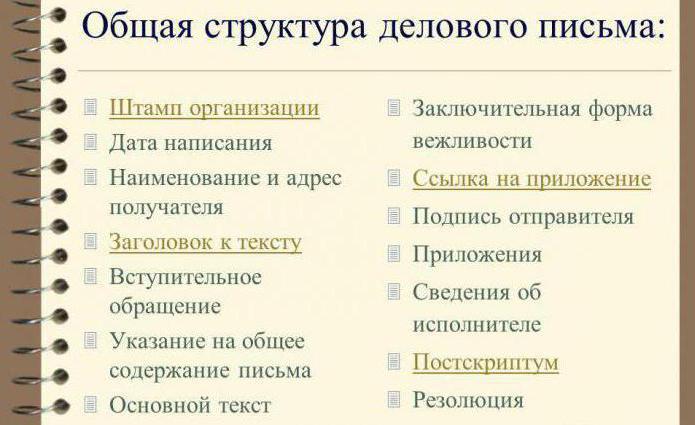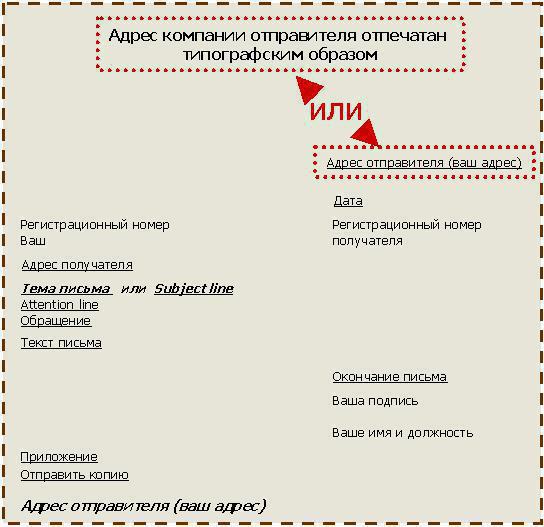Before compiling a message, you need to remember how the etiquette of a business letter and a personal letter differs. The most important thing is to observe the level of confidence in the presentation of the chosen topic. The addressee is likely to be imbued with this or that problem and will try to get involved in resolving the issues raised if he feels live communication in the lines of the letter. That is why those who know modern etiquette of business writing do not include in the text such anachronisms, such as “proceeding from the fact”, “you should” or even more forgotten “I hereby inform you”.

Characteristics
The business orientation and clear definiteness of the goal, the consistency in the statement of facts, the specifics of proposals and requests, and the information content of messages about actions and deeds have been preserved. Business letters began to be compiled in a more relaxed manner, however, they did not acquire open emotional expressions, epithets and comparisons from the features of personal correspondence; the old etiquette of business writing still prevails here. And only because the purpose of such a message is, as before, to submit a proposal, to which a specific answer must necessarily follow, the influence of the author of a business letter should be very great, since it motivates the addressee to actions of a specific nature. Moreover, the text is compiled in such a way that the author’s point of view does not represent his own attitude to the problem, but mutually beneficial interests in its solution.
The etiquette of a business letter prescribes not to use the pronoun "I", as is customary in personal correspondence, but emphasis on another pronoun - "you" is also appropriate here. If a business message is written without errors, printed accurately, the text is placed in accordance with all the rules and existing requirements, and therefore is not only easy to read, but also with pleasure, the correspondence will certainly have a continuation. Although today it is very often necessary to decipher whimsically twisted phrases, looking for the subject and the predicate in order to get to the bottom of their meaning. The rules of business writing are changing very quickly now. What a good tone was to write by hand. Then it was possible to be sure that the message was not made under carbon copy. How much personality could be seen in this message, and respect was always added to the relationship between the addressee and the author. It is a pity that this custom is completely out of date, and almost all letters have now become electronic.

Modern rules
A business letter, a sample of which will be presented below, represents the correspondence with a modern civilized act. Today, there are no less diverse rules that must be followed. Although, compared with the official language that existed in the country fifty years ago, these rules seem more like nuances or special subtleties. First of all, as the rules of business writing dictate, you must use a greeting in the personal address to your addressee before the text begins. Although corporations and any not-so-small organizations now have an internal connection of the ISQ format, where the answer follows the question, the question after the answer and in this quick correspondence, addressing by name is not necessary every time. However, the correct execution of a business letter implies an individual focus, and therefore personal appeal is necessary.
The subject of the letter in modern correspondence is usually placed in a separate field, and it must be filled in adequately, that is, according to the content.Correctly formulate the subject of the letter - get half the success, because this is the first thing that the addressee sees. The exact wording will help him to tune in the right way and perceive the information received quickly and in full. And you definitely need to inform the recipient about receiving his answer - this is a good tone, showing respect to colleagues and partners, this was done a hundred and two hundred years ago, and then you were in no hurry to live and knew exactly how to write a business letter. Today you need to respond to the message quickly, which helps e-mail - communication takes place very quickly. If you cannot immediately answer, you still need to send a message about the receipt of the response, where you indicate the time of the next communication session.

Time and place
It must be remembered that psychologically, the boundary of the response in time in its critical value is forty-eight hours. This is if there is no answering machine function. When two days have passed, the addressee is already full of confidence that his letter was left unattended or, at best, lost. The rules of the business letter contain this point: never delay the answer, because this is an indispensable loss of the client, and the partner will begin to worry and think about breaking up all kinds of relations. In any case, this is a gross violation of the ethics of business correspondence. If you need to send the same information, you can simply expand the mailing list. Putting all addresses in one “to” field greatly reduces delivery time, and transparency is maintained in partnerships: each person who receives the letter sees the list formed.
A great promise to continue partnerships is the polite phrase "thank you in advance." As it is written in a business letter and in what part it is placed - everyone decides for himself. Of course, the addressee should see it after the information has already been acquired and the impulse to act. At the end of the letter, in front of the contact block is the best place for this phrase. By the way, about contact information: it should be in every letter, not only in the first. The author’s phone numbers, position, and everything else cannot be forced to look. Making a business letter does not depend on the duration of the correspondence. Rules must always be followed. And in order not to guess whether the recipient received the letter, there is a request function. Only in this case can you be sure that it is read. Correspondence history must be preserved, you cannot write a response with a new message. However, when sending the entire communication tape to resolve a particular issue, it is necessary to remember not only subordination, but also confidentiality. If personal information is present in the correspondence, it must be deleted before reading by third parties.

The first option and introduction
How to write a business letter so that the addressee immediately becomes interested in this message, and his interest does not fade until the very end of the reading? There are three points that are almost magical for those who use them. First of all, this is a topic that a person sees before he opens an email. It depends on her whether this will take place, whether the addressee wants to familiarize herself with the message. The second point is the first introductory phrase, which sets the person to read. And of course, the ending is important. The phrase "thank you in advance" works very well. As written in a business letter, the ending is the most important moment, there are a huge number of options for the final phrases, the main thing is to choose the right tone. From the democratic "What do you say?" to the official "What will be your opinion on this issue?"
Now let's try to parse in detail the business sample letter.
Option 1.
Subject: Business Letter
Date: June 02, Friday
From: Ivan Petrov
To: Anna Sidorova
Hello, hello!
We invite you to an interview with employers on June 12 at 14.00. Since there will be other applicants, and the employers have planned to hold a meeting for only two hours, it is better not to be late.
Respectfully,
Ivan Petrov.
The second option and afterword
Subject: Business letter. Meeting with employers
Date: June 02, Friday
From: Ivan Petrov
To: Anna Sidorova
Hello, hello!
We carefully reviewed your resume and invite you to an interview with employers on June 12 at 14.00. Since other applicants will also be interviewed, and employers plan to hold a meeting for only two hours, it is better not to be late. And please, specify in the answer whether you will come, and also warn in advance if you cannot visit us at this time.
Respectfully,
Ivan Petrov.
Here is a typical business letter about a meeting, and according to the two options presented, it immediately becomes clear which of them is more effective. In the second variant, the addressee's attention is drawn to the subject of the letter, and he immediately understands what will be discussed. In addition, he will easily find this letter in ten days, by the time of the meeting, simply by looking at the topic, even if he receives fifty to one hundred letters daily. The subject perfectly identifies the message. That is, this letter is precisely about the meeting, and not about documents, not about payments, not about customers and the like - everything is clearly indicated. The introductory phrase slightly specifies the situation, adding mutual respect to the interlocutors: the first respected and wrote “carefully considered”, plus the result - an interview, and the second should be grateful for this. It also contains the reason for the letter. The last phrase obliges the addressee to write an answer.

Business position
The general rules for writing business letters apply to any correspondence, be it a letter in which a meeting is negotiated, or this is a letter of refusal to a failed partner. The structure is almost always the same, it can simply be remembered, but the content characterizes the author, and in his person the company that he represents as a civilized, correct and competent interlocutor. Correspondence is very often an emotionally costly and complex work, since communication by electronic means has become one of the main and, in principle, integral part of the work of a business person.
They write to colleagues about work, they write to management, business partners, and clients. They write to people who are well-known and to those who, quite possibly, will never have to see something. There are basically no requirements for compiling business letters according to a single model, textbooks have not been written yet, but the ethics of business communication have already developed, since it is precisely this that is the engine of successful business. A business letter is a business card of a company reflecting its official position. It depends on the correspondence whether the cooperation will be comfortable and productive, and whether it will take place at all. Therefore, following the rules of good manners in each message is the key to success.
Business Correspondence
The rules and norms of business correspondence electronically are exactly the same as the business community operates in any of its interactions - these are telephone conversations, negotiating and the like. There are several distinctive features that put electronic correspondence on a par with the long-established ways of business communication, and above all - this is the imperative of the time. The principles, however, remain the same and do not depend at all on how the business correspondence is conducted - whether it is an electronic letter or on paper.
1. Opponents must mutually respect both the individual and the business position of each other.
2. Opponents are always attentive to each other's business interests.
3. Confidentiality is always respected.
4. The exchange of information must be accompanied by punctuality.
Are these principles observed if the Subject field is not designed or is not clearly and correctly formatted? Not. The sender does not appreciate the time of the addressee, and he does not perform his task quickly enough. A client or partner on a specified topic will instantly appreciate the content of the message and the priority of reading. It is also important to know how to start a business letter. This is a personal greeting. This determines the confidence of the interlocutors, gives a certain personal focus. Ignoring the name of the recipient is unacceptable because it is considered incorrect.

Addressing
Here everything should be thought out to the smallest detail. Fields "To", "Copy" or - more importantly - "Bcc" are the most important tools for ethical communication and its efficiency. The modern business environment has already developed the basic tenets regarding the use of these fields. If the name is directly in the "to" field, the addressee must answer this letter, the sender of this answer is waiting, because the letter probably asked questions. If there are several names in the same field, this means that the sender will receive responses from each recipient. If the name is in the "Copy" field, it is not necessary to answer, just the sender needs you to be up to date. However, if the material of the letter interested and makes you participate in the correspondence, then you need a special phrase at the beginning, which will serve as a sign of good taste. Examples of phrases of a business letter, if the addressee’s name appears in the “copy” field: “Let me also speak on this issue ...”, “Let me join the discussion ...” or, more democratically, “Sorry to interfere ...”.
Etiquette particularly subtly indicates the situation when the name of the addressee is in the field "Bcc." In this case, business ethics is more vulnerable than ever, since this is perceived as an instrument of secret information and control. Nobody sees these recipients. And they see everyone and everything. Many companies in corporate correspondence prohibit this tool because they are scrupulous about business ethics. The only time this is allowed is through mass invitations (anniversary, corporate event, important meeting or negotiations), in which case the items will go to many addresses, but no recipient will see someone else's email address. Naturally, recipients from the Bcc field never enter into correspondence.
Informational content
Format, structure, volume, language - all this concerns the correct work with information. The peculiarity and nature of its submission is also a tool, an indicator of the desire to correspond and the ability to compose a competent text of the letter - respectfully and as correctly as possible with respect to the addressee. The text is best perceived in the volume that fits on one screen, that is, A4 sheet format. Attachments sent with a letter should not exceed three megabytes, because they may not be missed by the mail server of the recipient. Files that are sent will not cause problems to the recipient if universal rar or Zip encodings are used. The text of the answer should be placed at the top, and not at the bottom, that is, at the beginning of the letter, which will save the recipient from searches.
The answer, as already mentioned above, cannot be written as a new letter, you must save the history of correspondence so that the addressee does not look for the original message. The language of business writing should be as simple and understandable as possible, with a minimum of use of internal corporate, professional vocabulary, slang, Englishism, acronyms and abbreviations. However, it is possible to apply all this within the company during correspondence, since in this way both efficiency and communication speed are significantly increased, and therefore it is considered acceptable and completely ethical. Internal correspondence usually consists of abbreviations and slang consists almost completely. But in communication with external partners or business clients, such cases almost never occur.

A bit about terms
It is sometimes impossible to do without terminology, especially in specialized companies. Another question is that the necessary words introduced into the business context need to be explained, and the interlocutor must be taught how to use them. For example, a client wants to advertise their products on the Internet, and a manager selling these services writes phrases that are completely incomprehensible to an outsider with such turns as “keywords”, “contextual banner” and so on. However, you cannot do without them, and therefore you have to train the client.